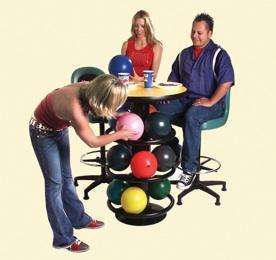The average bowling ball used during a trip to your local residential bowling alley weighs anywhere from six pounds to sixteen pounds. With such a broad range of weights, how can you tell which ball is right for your needs? The weight of the ball is the single most important element of bowling, and using the right ball can drastically improve your skill level, as well as prevent injury during a game.
How Heavy Is Too Heavy?
The simplest way to find the right bowling ball weight is by using a few different ones and determining which feels “right,” to put it simply. If you’re sore after bowling a few games with a 15-pound ball, look for something lighter. Conversely, if it feels a little too easy to play using a 10-pound ball, you may need to size up.
Heaviest Is Not Always Best
Sure, the heavier the ball, the more force there is for knocking down pins; however, the ball must still be light enough to attain speeds while flying down the lane. The most ideal ball weight is the heaviest ball that can still be rolled easily and consistently every turn. Some may look for the heaviest possible ball in order to impress friends or teammates, but this can lead to injury while playing if the ball isn’t the right fit.
How to Find the Perfect Bowling Ball
Factors vary from person to person, but the general rule of thumb dictates:
- Men usually need a bowling ball weighing 14 to 16 pounds.
- Women typically bowl best using a ball that weighs anywhere from 10 to 14 pounds.
- For children ages 6 to 14, parents can use their unique age to find a corresponding weight, for example: a 7 year old would need a 7-pound ball, and a 12 year old might use a ball weighing 12 pounds. For children or teens looking to play professionally: bowlers should be able to handle balls 12 pounds or more. Professional balls start at 12 pounds and include performance-enhancing advantages such as resin coverstocks.
- Pay attention to finger holes when shopping for bowling balls, as their size can indicate whether or not the ball will suit the bowler. If the holes feel too large or too small, it can mean that the ball is too heavy or too light. This can vary based on physical strength, however, and upper body strength should be a factor when deciding.
- Bowlers with wrist or back problems should seek slightly lighter bowling balls, in general.
- Some say your bowling ball should weigh 10% of your body weight. For example, if you weigh 150 pounds, try a 15-pound ball to practice on.
Performance-Enhancing Features
Modern bowling balls feature shells and inner cores that enhance performance without adding excess weight.
- In general, the weight of a bowling ball is determined by its inner core, but specially made cores can increase impact without adding weight. Nowadays, traditional 3-piece cores are being replaced by 2-piece cores for better (and lighter) performance.
- The core is surrounded by a shell, called a coverstock, made from mediums like resin or urethane; two light materials that allow for better results without added weight.
Finding the ideal bowling ball weight will drastically improve your game and prevent injury. Whether you’re looking to play professionally, or just enjoying a casual game with friends, these simple tips and tricks will help make sure the ball you’re using is the correct weight. For more about the right equipment, and tips for a better game, subscribe to the Murrey Bowling blog or email Sales@MurreyBowling.com.


